Partner F.O. Matthiessen
Queer Places:
Cheney Brothers Historic District, 135 Hartford Rd, Manchester, CT 06040, Stati Uniti
Yale University (Ivy League), 38 Hillhouse Ave, New Haven, CT 06520
Académie Julian, Passage des Panoramas, Paris, France
The Art Students League of New York, 215 W 57th St, New York, NY 10019, Stati Uniti
87 Pinckney St, Boston, MA 02114
Cheney House, Old Ferry Ln, Kittery, ME 03904, Stati Uniti
East Cemetery, Manchester, Connecticut 06040, Stati Uniti
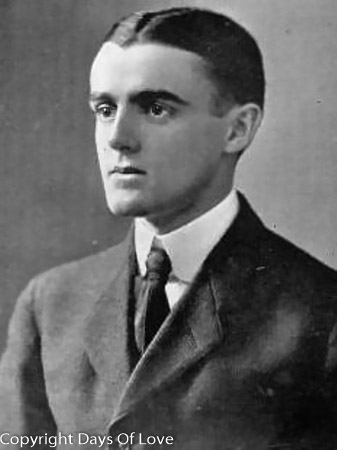 Russell
Cheney (October 16, 1881 – July 12, 1945) was an American Impressionist,
Post-Impressionist and New England regionalist painter. F.O. Matthiessen,
newly graduated from Harvard and embarking on his career as a cultural
historian, wrote to his lover, the painter Russell Cheney,
about his reaction to reading the work of the sexologists in 1924. Having read
Edward Carpenter's The
Intermediate Sex in one day, he recalled the work of
Havelock Ellis. “Then for the
first time it was completely brought home to me that I was what I was by
nature . . . . Was it possible for love and friendship to be blended into
one?” He discovered that it was, since his relationship lasted until Cheney's
death in 1945.
Russell
Cheney (October 16, 1881 – July 12, 1945) was an American Impressionist,
Post-Impressionist and New England regionalist painter. F.O. Matthiessen,
newly graduated from Harvard and embarking on his career as a cultural
historian, wrote to his lover, the painter Russell Cheney,
about his reaction to reading the work of the sexologists in 1924. Having read
Edward Carpenter's The
Intermediate Sex in one day, he recalled the work of
Havelock Ellis. “Then for the
first time it was completely brought home to me that I was what I was by
nature . . . . Was it possible for love and friendship to be blended into
one?” He discovered that it was, since his relationship lasted until Cheney's
death in 1945.
The youngest of eleven children Cheney was born in Manchester, Connecticut
to Knight Dexter Cheney and Ednah Dow Cheney.[1]
He graduated from Yale University in 1904, where he was a member of the Skull
and Bones secret society.[2]
Cheney studied at the Art Students League with Kenyon Cox and George Bridgman
until 1907. He continued his art education in Paris under Jean Paul Laurens at
the Académie Julian. After his father's death in 1908, he returned to America
and continued with Cox and William Merritt Chase at the Art Students League.
In 1909 Cheney was elected president of the League (the same year he exhibited
at the Salon des Artistes Francais); he resigned a year later but continued to
take classes there, studying with Chase as a private pupil. Cheney spent the
summers between 1911 and 1914 painting in York and nearby Ogunquit, Maine. In
1912 he studied there with Charles Woodbury. His first American exhibition was
shown at the Fourth Annual Exhibition of the Connecticut Academy of Fine Arts
in 1914 .[3]
His first New York exhibition was in Babcock Galleries 1922. His portrait of
Professor Candle hung in the Paris Salon in 1909 and his work has been
exhibited in the Boston Museum of Fine Arts and the San Francisco Museum of
Art among others. Cheney illustrated F. O. Matthiessen's book Sarah Orne
Jewett (1929), a work on the life and
work of writer of the same name. A catalogue of Cheney's paintings was
published in 1922. Cheney was a member of the Connecticut Academy of Arts and
Sciences, Colorado Springs Fine Arts Center, and San Francisco Art Society.
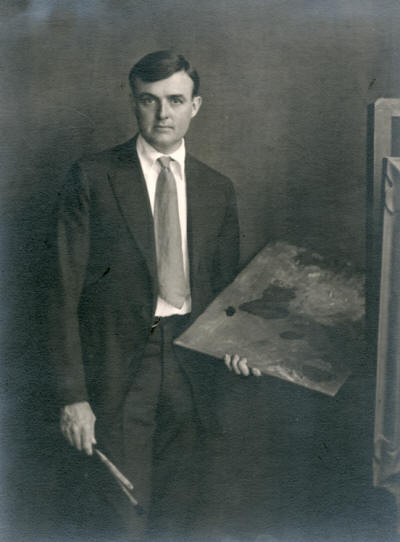


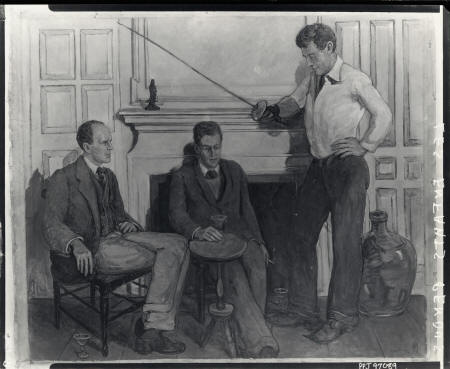
Les Enfants Pendus [painting], "Russell Cheney, 1881-1945: A Record of his Work with notes by F. O. Matthiessen," New York: Oxford University Press, 1947.
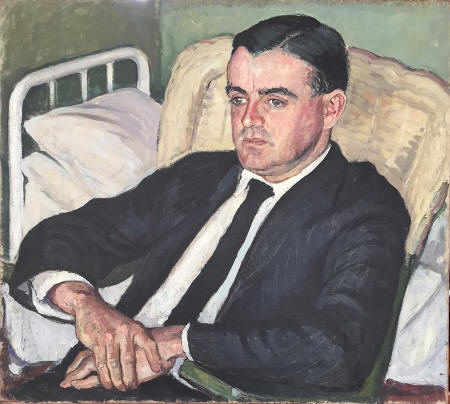
Portrait of Russell Cheney by Henry Varnum Poor (1916). The painter and ceramist Henry Varnum Poor (1888–1970) and Russell were close friends and corresponded frequently. Poor visited Russell at Cragmor in 1916–17. The portrait was rediscovered at auction nearly 100 years later by Ulrich Birkmaier who recognized it from the black and white image in F.O. Mattheissen’s retrospective catalog.
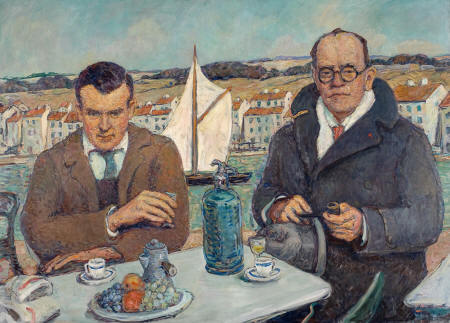
At Cassis or Two Painters (Russell Cheney and Walter Griffin), 36×50″ 1930

F.O. Matthiessen (Florence, Italy), 32.5×25.5″ 1926

F.O. Matthiessen with Pansy Littlefield, 24.5×30″ 1926
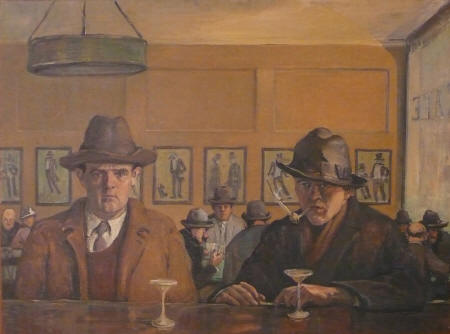
Les Copains (Russell Cheney and H.P. Putnam in Cassis), 38×51″ 1923
.jpg)
Yale University, New Haven, CT
Cheney's health was poor and he spent two years in a Colorado tuberculosis
sanatorium and subsequently spent winters in warm climes. He was the longtime
partner and lover of author
F. O. Matthiessen,
who was also a Yale graduate and became a member of Skull & Bones in 1923.
They met aboard an ocean liner on the way to England in 1924 and were lovers
until Cheney's death in 1945. Mathiessen affectionally nicknamed Cheney "Rat",
while Cheney called Mathiessen "Devil". The two exchanged over 3000 letters
during their years together. Though the family was mystified by his
relationship with Mathiessen, they were more disturbed that Cheney had left
the mill town of Manchester, CT, for a career in the arts than that he was
openly involved with another man. Though they never stopped loving their son,
at his funeral the animosity towards Mathiessen came out and they treated the
grieving man coldly. Both were very reticent during their first meeting. After
days of intense personal conversation on the boat where they shared some of
their innermost secrets as well as laughter and camaraderie, Mathiessen was
still afraid to say he was gay. At one point he steered the conversation
towards Havelock Ellis but again shrank from coming out to Cheney. Finally, at
some point after 2 am on the 4th day of the voyage and back in Mathiessen's
cabin with Cheney safely biting into a pear, Mathiessen awkwardly said, "I
know it won't make any difference to our friendship, but there's one thing
I've got to tell you: before my senior year at Yale I was sexually inverted.
Of course I controlled it since." After a moment of silence that to Mathiessen
was one of the most frightening of his life, Cheney confessed he too was gay.
There followed two hours of even more intense conversation. Later, Cheney
asked if a Bartlett pear was the antidote for the apple in the Garden of Eden.
In the earliest letters, they discussed the possibility of same-sex marriage.
"Marriage! What a strange word to be applied to bed! Can't you hear the
hell-hounds of society having full pursuit behind us? But that's just the
point. We are beyond society." They did not pledge monogamy to each other,
though they knew from the beginning that they would be life partners.
Mathiessen suffered from depression. Feeling suicidal, he checked himself into
McLean Hospital just after Christmas 1938. When he was released three weeks
later, he and Cheney rented an apartment at 87 Pinckney St, Boston, to
establish an in-town base. Mathiessen eventually bought the entire Pinckney St
building.
Russell was supported by his family and later when the family business was
dissolved he was supported by Matthiessen.
Matthiessen was twenty years Russell's junior. Russell's death was due to
mesenteric thrombosis. He was buried in East Cemetery in Manchester,
Connecticut. He was survived by Matthiessen, two sisters, Ednah Cheney
Underhill of Santa Barbara, California and Mrs. Halstead Dorey of Boerne,
Texas.
My published books:/p>


BACK TO HOME PAGE

- https://en.wikipedia.org/wiki/Russell_Cheney
- Rupp, Leila J.. A Desired Past (pp.100-101). University of Chicago
Press. Edizione del Kindle.
- Improper Bostonians Lesbian and Gay History from the Puritans to
Playland By History Project Staff · 1998
- The Hub of the Gay Universe, An LGBTQ History of Boston, Provincetown,
and Beyond, by Russ Lopez, 2019
- Shand-Tucci, Douglass. The Crimson Letter . St. Martin's Publishing
Group. Edizione del Kindle.
 Russell
Cheney (October 16, 1881 – July 12, 1945) was an American Impressionist,
Post-Impressionist and New England regionalist painter. F.O. Matthiessen,
newly graduated from Harvard and embarking on his career as a cultural
historian, wrote to his lover, the painter Russell Cheney,
about his reaction to reading the work of the sexologists in 1924. Having read
Edward Carpenter's The
Intermediate Sex in one day, he recalled the work of
Havelock Ellis. “Then for the
first time it was completely brought home to me that I was what I was by
nature . . . . Was it possible for love and friendship to be blended into
one?” He discovered that it was, since his relationship lasted until Cheney's
death in 1945.
Russell
Cheney (October 16, 1881 – July 12, 1945) was an American Impressionist,
Post-Impressionist and New England regionalist painter. F.O. Matthiessen,
newly graduated from Harvard and embarking on his career as a cultural
historian, wrote to his lover, the painter Russell Cheney,
about his reaction to reading the work of the sexologists in 1924. Having read
Edward Carpenter's The
Intermediate Sex in one day, he recalled the work of
Havelock Ellis. “Then for the
first time it was completely brought home to me that I was what I was by
nature . . . . Was it possible for love and friendship to be blended into
one?” He discovered that it was, since his relationship lasted until Cheney's
death in 1945.








.jpg)

